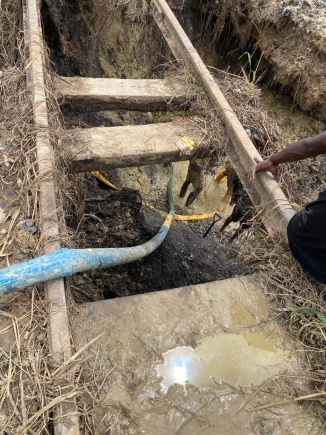About three kilometres of the 60-kilometre Takoradi–Akyem–Nsuta rail line in the Western Region have been destroyed by illegal mining (galamsey) acti
About three kilometres of the 60-kilometre Takoradi–Akyem–Nsuta rail line in the Western Region have been destroyed by illegal mining (galamsey) activities, forcing a halt to manganese haulage and other operations of the Ghana Railway Company Limited (GRCL).
The extensive damage, discovered last Wednesday, October 1, 2025, has left sections of the track, sleepers and embankments severely compromised at Akyem, a community near Nsuta in the Tarkwa-Nsuaem Municipality. Large portions of land beneath and around the line have been excavated and destabilised, highlighting yet another devastating consequence of the galamsey menace on critical national infrastructure.
Would you like me to continue with a follow-up section — for example, statements from GRCL officials, eyewitness accounts, or the government’s planned response?
The destroyed stretch of the rail line no longer sits on solid ground but now hangs precariously over deep pits dug by illegal miners, with other portions buried under loose sand and debris.
The extent of the destruction only came to the attention of the Ghana Railway Company Limited (GRCL) last week, after a passer-by alerted the District Manager about the alarming condition of the line. Upon inspection, officials confirmed that the integrity of the affected section had been completely compromised, posing a severe risk to rail transport and personnel in the area.
Would you like me to include what actions GRCL or the Ministry of Railways has taken since the discovery (e.g., halting operations, assessing repairs, or involving security)?
Officials of the Ghana Railway Company Limited (GRCL) said a full-scale technical assessment was underway to determine whether the destruction was confined to the Akyem section or extended to other parts of the Takoradi–Nsuta rail corridor.
Preliminary estimates suggest that repairs could cost the company at least $18 million, covering track restoration, earthworks, and reinforcement of weakened foundations.
Sources close to the company revealed that the illegal miners allegedly acquired access to the land from some local traditional authorities, who have reportedly condoned and supported the unlawful activities. The intense, round-the-clock mining has not only crippled the rail line but also severely degraded the surrounding environment, leaving gaping pits and unstable ground along the route.
The miners are said to have acquired the land, including the Ghana Railway Company’s right of way and buffers, in the community.
The galamseyers in the community are said to deploy a technology known locally as “one leg”, which involves the combination of a big water hose and a high-pressure water pump to wash the earth after initial digging by an excavator.
The “one leg” is said to be more deadly in terms of speed of destruction of the environment than the conventional excavators.
The illegal miners are reported to have encroached on the Ghana Railway Company’s right of way and buffer zones, acquiring and operating within areas legally reserved for rail infrastructure.
According to local sources, the miners employ a destructive technique known as “one leg” — a method that combines the use of high-pressure water pumps and large hoses to blast through soil and wash out gold-bearing material after initial excavation.
This “one leg” technology, though less equipment-intensive, is far more devastating and faster in degrading the land than the use of conventional excavators. The process leaves behind deep craters, weakens the ground, and has now compromised the stability of the railway foundation, posing a serious safety risk.
The illegal miners are reported to have encroached on the Ghana Railway Company’s right of way and buffer zones, acquiring and operating within areas legally reserved for rail infrastructure.
According to local sources, the miners employ a destructive technique known as “one leg” — a method that combines the use of high-pressure water pumps and large hoses to blast through soil and wash out gold-bearing material after initial excavation.
This “one leg” technology, though less equipment-intensive, is far more devastating and faster in degrading the land than the use of conventional excavators. The process leaves behind deep craters, weakens the ground, and has now compromised the stability of the railway foundation, posing a serious safety risk.
“Within just a few months of trying to put things in order, the galamseyers took advantage of the situation and invaded the rail lines,” Mr. Aggudey lamented. “They destroyed a long stretch of active track, completely bringing our operations to a halt.”
Current Situation
According to Mr. Aggudey, the challenge now extends beyond merely repairing the rolling stock or resuming service. The illegal mining activities, he explained, have quadrupled the company’s maintenance costs, with enormous resources now needed to restore the damaged tracks, stabilize the ground, and ensure the safety of future rail operations.
“The activities of these galamseyers were not unknown to us,” Mr. Aggudey revealed. “Sensing the danger ahead, we wrote to the sector ministry and, as a proactive step, engaged the chiefs and leaders of the Akyem community. They assured us that the miners would not go near the railway lines and that the degraded areas would be reclaimed.”
He described it as mind-boggling that the community stood by while such extensive damage was inflicted on critical national infrastructure.
“As we speak, the miners are operating openly, day and night, with an alarming level of impunity,” Mr. Aggudey added.
The Deputy Chief Civil Engineer explained that the company’s financial situation had made it impossible to carry out repairs at the moment.
“At present, we simply do not have the resources to fix the damage — the cost is far beyond our financial capacity, especially when workers’ salaries are already in arrears,” he said.
He described the situation as grave and crippling, noting that the destruction caused by the illegal miners had placed the company in a dire operational and financial position.
Mr. Aggudey, however, expressed optimism that the government’s renewed anti-galamsey campaign in the region and across the country would help clear the illegal miners from the railway corridor, allowing the company to restore operations.
